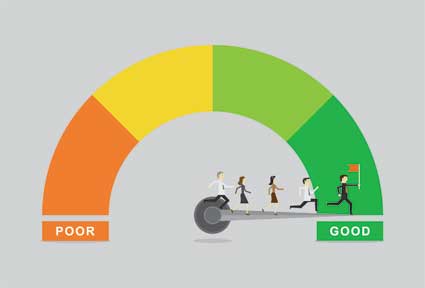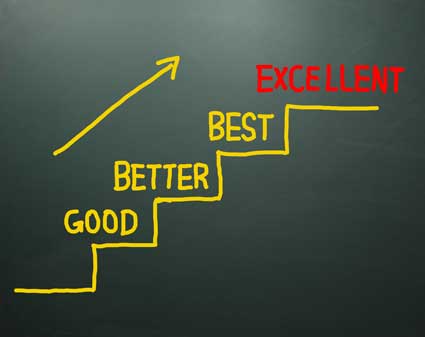A plan that sits on a shelf collecting dust is a waste of money and doesn't do an organization any good. The strategic plan does not move an organization into the future if it's not being utilized, updated or revised when needed. The plan should be revised when major events such as legislation affecting the organization is approved, new technology changes the face of the industry's environment, or any other major event leadership deems as necessary for changes to the strategic plan to be made.
The plan should be used to measure the organization's health and standing within its industry and be its guiding force as it moves into the future. Because of its importance and far-reaching affect, the plan should be revised and updated at planned intervals. Some organizations revise their plan every year while others wait three to five years. One of the main reasons organizations revisit their plan annually is the review process places the organizations core values and goals in each employee's mind's eye once again ensuring they are aligned with the institution's priorities. Business Insider reported that in 2013 the average employee only stayed with a company for about nine months, which makes uniting everyone around an organization's main values and goals imperative.
If the plan is not revised annually, it should be formally reviewed and any items that are outdated or creates an issue within the organization should be revised at that time. Barring any unforeseen major legislative measure or exceptional conditions deemed serious by leadership, a well-written plan for large organizations should not need annual major revisions.
But there are some areas within a plan that might need semi-annual reviews, especially in the plan's first year. As a minimum, leadership and upper management should evaluate the plan on an annual basis to measure the organization's progress toward its established goals. But at the same time, do not become so obsessed with planning and revisions of the plan that nothing ever is accomplished except for work on the plan. The plan is there to work for the organization.
On the positive side of handling the planned and even unplanned reviews and revisions is the fact that a majority of the beginning processes do not need to be repeated. Also, there were many lessons learned with the initial process, so numerous missteps will be eliminated with revisions and rewrites. Also the process is now familiar within the organization and fewer explanations will be needed to receive assistance and obtain answers while making said revisions.
Semi-annual Review
There are certain areas within a strategic plan where organizational leadership may require a semi-annual review – especially the first year of a plan. One of the obvious areas would be with the plan's budget. Leaders need to monitor expenses and ensure expenditures are falling within budgeted expectations. On the other side of the ledger, changes implemented in the plan to reduce expenses or increase revenue need to be monitored to see if they are meeting set goals too.
Other areas that could be deemed necessary for semi-annual review include areas where dramatic changes were made in the tactics used within the organization or if the whole department was revised and a new mission assigned. These areas need to be reviewed for: progress; if tactics are valid; required resources are available; training is adequate; and if goals are feasible and are being met. If not then tactics need to be revised and goals should be reevaluated and changed as deemed necessary.
This review process does not need a new plan generated but if major changes are needed in one area of the plan, that area should be revised and immediately be implemented so the organization can continue moving forward towards its ultimate goals.
For minor changes in the semi-annual review, the following items should be looked at and any updates or revisions required should be made to Reviewing tactics or departments linked to the revised tactics to ensure shared resources and the work flow has not been affected
- Resources are still adequate to meet the needs
- Goals are still achievable and realistic
For moderate changes the following items should be looked at and any updates or revisions required should be made:
- Reviewing tactics or departments linked to the revised tactics to ensure shared resources and the work flow has not been affected
- Resources are still adequate to meet the needs
- Goals are still achievable and realistic
- A timeline set for reviewing changes to see if any further revisions are required
- A leadership review of the changes should be scheduled
If major revisions are needed then leadership needs to be called in to determine the extent of the plan's overhaul. Major revisions at a minimum will affect the budget, resources and possibly one or more departments. This could mean revisiting a significant portion of the plan, if not the whole plan. For this reason, an immediate meeting should be set up with leadership and subject matter experts to discuss the scope of the plan's overhaul.
Leadership Annual Review
The annual review by leadership is designed for the organization's leadership to take stock of the institutions progress. As a minimum leadership should look at the following:
- Have the immediate goals been met in the plan?
- Are the resources allocated meeting demands or are there shortfalls?
- Are there major changes within the organization not addressed in the plan?
- Are there any legal changes made or on the table that voids any portion of the plan?
Is the organization on schedule to meet its intermediate goals outlined in the plan?
- Is the plan's budget within programmed expectations?
- Have planned improvements in tactics met expectations?
- With the experience garnered this year working the plan, is there anything missing in the plan? If so, does this issue need to be addressed immediately or can it wait for the planned overall review?
If any of the answers fall short of expectations, then leadership should bring in the subject matter experts and that area of the plan needs to be addressed. Proper revisions should be made to that area with the changes being monitored periodically to ensure the revision was adequate.
Annual Review Initiation
When it is time for review, leadership should have a checklist of the various leaders, managers, and shareholders who have responsibility for reviewing, revising and updating the plan. The simplest way to notify the proper individuals of this requirement is to send each person an email along with instructions and guidelines for reviewing and revising the plan. An organization's IT may be needed to assist in this process so the actual plan is available for review on a secured web site by all the necessary individuals.
The question leadership must determine is when to begin the process – one, three or six months out? For organizations requiring their plan to be reviewed annually three months out is plenty of time since the various members are familiar with the plan and the review process. If the process were to begin six months out most people will feel they just finished the review and will bury the plan in the proverbial black hole on their desk. For plans being reviewed every three or more years, it's best to start the review ball rolling six months out.
There are many ways to make everyone in the organization aware the strategic plan is being reviewed – from an article in the organization's newsletter to an e-mail from leadership or even signs in the break-room. Whatever means used, the simple purpose is to get everyone in the organization to realize the review process is beginning.
Revising and Updating the Plan
One of the first things that should take place six months out with the initial start of the review is for leadership to review the plan and discuss the gains and misses that took place during the year. At a minimum a strategic plan review by leadership should:
- Compare actual with projected results
- Compares estimated timetables with documented completion dates
- Grade the plan on whether it's on time and target
The annual review by leadership should give strong indications on how well the plan is working so that when something is noted within the plan's review it should not come as a complete surprise to the organization. If leadership's findings did see some things were not going as planned then they should have the necessary resources aligned and ready to make the needed updates and revisions to the plan.
Also at the six month mark, each major department should form a planning committee to develop a plan of action for the various sections within the department.
Each department's plan of action should include:
- A scheduled retreat to review the previous years' gains and misses and to set goals for the new plan
- Reviewing the historical data for resources and setting new requirements
- Updating as needed any legal requirements within the plan
- Listing the latest industry trends and technological advances
- Checking on competitors to see what's new with them
A review and evaluation that shows there are no major changes either within the department and its external environment; tactics are proceeding on schedule and goals are being met; then the department should reconfirm its tactics and goals with the minor necessary adjustments and continue moving forward following the plan.
On the other hand, if the review process reveals significant changes within the department, in legislation that affects its processes, or the industry as a whole has changed, tactics are not working, goals are not being met, and unexpected problems are being noted, then major revisions are in order.
Circumstances likely to trigger a plan's revision are:
- Dramatic changes in funding levels – operating expenses spike or asset maintenance expenses soar
- Internal reorganization
- Product changes
- Competition reorganization or revamps its strategies
- Significant changes in economy
- Unforeseen new markets emerge
- Audit discoveries
- Input from major shareholders
- Working knowledge and experience with the plan reveals a need for revision
- New technology that changes the landscape
- Natural or manmade disaster that affects the economy, industry landscape, or the organization
At the three month mark there should be a large meeting of some type where all the planning committees present their plans. This should be an informal and open forum so questions can be asked and suggestions made for improvement. The other significant thing that should begin at this time is the budget process for the new plan.
At the thirty day mark each department's review and revisions should be in their final stages. Tactics should be nailed down and goals are listed for review by the organization's leadership. At this point plans should begin their approval processes so the plan is ready to be launched at the beginning of the organization's fiscal year.
At the beginning of the fiscal year the new strategic plan should be launched and all the new processes should take effect. Copies of the new plan should be made available to all managers and leadership.
Sample Strategic Questions to Ask When Revising and Updating Plan
When reviewing the strategic plan, instructions being sent within the email should dictate that individuals closely look at the plan's tactics and goals and ensure all are still valid.
Questions that individuals should be asking when validating various components of the plan are:
Has the internal capacity changed significantly since the last review?
- Has the mission changed?
- Any new goals implemented?
- Has the organization taken on any new responsibilities that affect goals?
- Has the organization's finances dramatically changed and affected the budget?
- Has organization procedures changed either through regulations and guidelines or through improved innovation?
- Have audits turned up repeated or significant findings?
Are there any major changes in the organizations external industrial environment?
- Is there any new legislation affecting the organization?
- Are there any new watch groups focusing on the organization or its products?
- Have there been any economic or other external shifts that could affect the organization?
- Has a major competitor moved into the area?
Are tactics and goals on schedule within the plan and meeting all expectations?
- If this is the case is the organization capitalizing on this positive outcome?
- If goals are being greatly exceeded, should they be raised?
- Goals that are not being met, should they be revised or are other changes needed? What is the cause behind the failure?
Are meeting the plan's goals enough of a report card to indicate the plan's progress and guide leader's decisions?
- Are there enough execution indicators built-in to the tactics to chart progress and flag management when changes are needed?




























